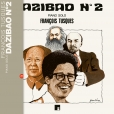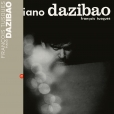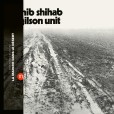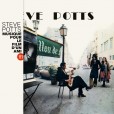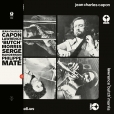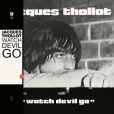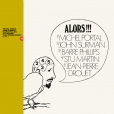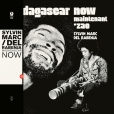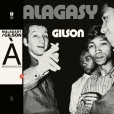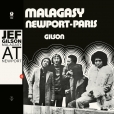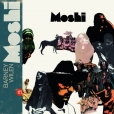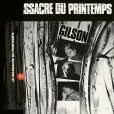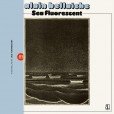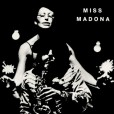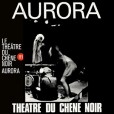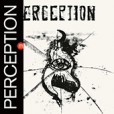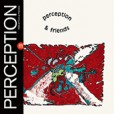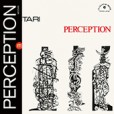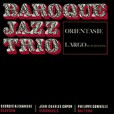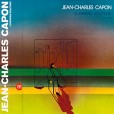Your basket is empty

A second set of piano improvisations, one year after the first, now more extended, percussive, insistent, and tumultuous; explicitly enraged by the recent murder of George Jackson by a San Quentin guard, and the massacre at Attica Prison.
Reaching solo-piano explorations in blues, jazz and classical music by the Free Jazz pioneer, in 1970; inspired by the revolutionary spirit of the times, and — opening with a dedication to Don Cherry — the New Thing.
This saxophonist came through with the likes of Roy Ayers and Joe Henderson in the sixties, before hooking up with Steve Lacy in Paris in 1973. In this soundtrack composed for a film by his friend Joaquin Lledó — entitled Le Sujet Ou Le Secrétaire Aux Mille Et Un Tiroirs — he was joined by members of the group around Lacy, and diverse co-conspirators including friends from the funk outfit Ice, French accordionist Joss Bassellion, and none other than Jef Gilson at the mixing desk. It’s a dazzling, intensely entertaining blend of modal, cosmic and spiritual jazz, free funk, dirty grooves, heavy jams, bistro boogie and Javanese wah-wah.
The fruits of a recording session deftly convened by Jef Gilson, to take advantage of Serge Rahoerson’s visit to Paris from Madagascar for just a few days in November 1976. Though a saxophonist by training, Serge had played drums on The Creator Has A Master Plan for the Malagasy album. To establish rhythmic foundations, Gilson reunited him in this capacity with Baroque Jazz Trio bassist Jean-Charles Capon. Recruited from Gilson’s current big band, Saravah saxophonist Philippe Maté and cornetist Butch Morris — on the verge of hooking up with David Murray — added their contributions later.
‘Four years after a first album on the Futura label in 1971, Jacques Thollot returned, this time on the Palm label of Jef Gilson, still with just as much surrealist poetry in his jazz. In thirty-five minutes, the French composer and drummer, who had been on the scene since he was thirteen — recording Gilson LPs when he was just sixteen — established himself as a link between Arnold Schoenberg and Don Cherry. Resistant to any imposed framework and always excessive, Thollot allows himself to do anything and everything: suspended time of an extraordinary delicacy, a stealthy explosion of the brass section, hallucinatory improvisation of the synthesisers, tight writing, teetering on the classical, and in the middle of all that, a hit, the title-track — which Madlib would one day end up hearing and sampling.
‘In a career lasting half a century, centred on freedom, Jacques Thollot played with a roll-call of key experimental musicians (Don Cherry, Sonny Sharrock, Michel Roques, Barney Wilen, Steve Lacy, François Tusques, Michel Portal, Jac Berrocal, Noël Akchoté...) who all heard in him a pulsation coming from another world.’
The illustrious clarinettist alongside John Surman, Barre Phillips, Stu Martin, and Jean-Pierre Drouet, in 1970. Iconic Futura cover-art by Avoine.
Outstanding modal set for Futura in 1971, with the superb French trio Georges Arvanitas, Jacky Samson, and Charles Saudrais, expertly proliferating Mingus and Trane.
These two sharpened their musical skills in the celebrated seja-jazz band from La Réunion, Le Club Rythmique. In 1967 Sylvin Marc put out a terrific funk 45, saturated in James Brown. Later, he would play bass for Nina Simone on her album Fodder On My Wings, whilst Del Rabenja would work with Manu Dibango.
In these 1972 recordings for Jef Gilson’s Palme label, they are joined by their Madagascan compatriots Ange Japhet, Gérard Rakotoarivony and Frank Raholison — comprising the same group of five which lights up Funny Funky Rib Crib by Byard Lancaster and Soul Of Africa by Hal Singer & Jef Gilson.
The first side showcases the valiha harp-playing of Del Rabenja: three excursions in tribute to the great Rakotozafy, hypnotic and full of spirituality. The second side presents four compositions by Marc — free, grooving and cosmic.
The fabulous, legendary LP originally issued by Lumen in 1972, born out of several visits to Madagascar by Gilson and fellow musicians from Paris, and their collaborations with musicians on the island.
Fittingly the first trip was on May 13 1968, the day of the general strike in France: this is tumultuous, insurgent, joyous, blisteringly swinging, outernational Malagasy jazz, including a a charged, unmissable The Creator Has A Masterplan, and Avaradoha, a composition by Madagascan saxophonist Serge Rahoerson (who leads this recording), which was the anthem of the rotaka protests in 1972, bringing down the neo-colonial First Republic of Madagascar. The closer showcases various traditional Madagascan percussion instruments, played by the same trio which that year recorded Le Massacre Du Printemps, Gilson’s avant-noise homage in memoriam of Stravinsky.
Hot.
Jef Gilson, Sylvin Marc and his cousin Ange Japhet, Del Rabenja, Gérard Rakotoarivony and Frank Raholison, blending together bebop, sub-Saharan roots and electric funk.
Requiem Pour Django, Dizzy 48 and Anamorphose — renamed Salegy Jef after this re-routing via Madagascar — rejuvenate Gilson compositions from the previous couple of decades. Newport Bounce is a reworking of Interlude, recorded by Gilson in 1969 with Philly Joe Jones. Le Newport was a club in rue Grégoire de Tours, Saint Germain des Prés.
Inspired, free, luminous music-making. An outernational holy grail and a stiff tonic for all citizens of nowhere.
Already the great French jazz saxophonist had made monumental records alongside all-time legends like Monk, Blakey, Bud Powell and Miles — that’s Wilen on Lift To The Scaffold — before cutting loose at the end of the sixties on a two-year journey through Morocco, Algeria, Niger, Mali, Upper Volta (now Burkina Faso) and Senegal, with a team of film-makers, technicians and musicians.
Moshi means trance utterance — the moshi is a demon invoked by the Fulani Borogi of Niger, to chase away angst and depression — and this is a shamanistic bricolage of smoky musical spells and scraps of intimate, outdoors ambience, full of love, good vibes and gritty musical wonder, drawn from more than fifty tape reels recorded en route: desert blues, space-jazz, street-funk, acid rock, polyphonic rhythms and new-thing influences like Shepp and Sanders; buzzing, extended ensemble sessions, like alternative Bitches Brews, crossed with diverse snippets of magic grabbed on the wing, like Algerian gnawa, or solo mbira, or just people laughing together, or a Bamako griot…
Beautifully presented, with a twenty-page booklet, and the DVD of Caroline de Bendern’s vivid, freewheeling film A L’Intention De Mlle Issoufou A Bilma, about the trip.
Fervently recommended.
Highly sought-after French jazz fusion — blending in West Coast funk, gentle blues, sketches of Andalusia — with John Hicks, Jerry Goodman from the Mahavishnu Orchestra, and Jean-Marie Fabiano from the Fabiano Orchestra.
From 1976, the first of the two albums by the Asocial Associates, led by Philippe Doray of Rotomagus.
‘Psychedelic pop, voodoo rock, wrong krautrock, woozy swing… bringing to mind as much Hendrix as Areski, Ash Ra Tempel as Berrocal. No wonder that Nurse With Wound lists Philippe Doray between the Doo-Dooettes and Jean Dubuffet. One of the best albums of experimental song ever recorded.’
The first of a fascinating trio of LPs — this for Futura in 1970, by Hungarian saxophonist Yochk’O Seffer, German pianist Siegfried Kessler, French bassist Didier Levallet and Vietnamese drummer Jean-My Truong.
‘Lyrically incandescent free jazz, made up of startling interactions between complex harmonies and disjointed rhythms.’
‘The second LP, from 1971, augmenting the original quartet with numerous guests including Teddy Lasry, Jean-Charles Capon, Kent Carter and Jean-François Jenny-Clark. Siegfried Kessler is largely absent on this recording, temporarily replaced by Manuel Villaroel, a pianist from Chile with a completely different temperament.
‘It all seems to predict the after-life of Perception would subsequently take. One track, by Yochk’O Seffer, who had already been part of Magma two years previously, looks forward to the more structured Neffesh Music, whilst, in the opposite direction, another track, by Didier Levallet, is more evocative of the future arrangements on Swing Strings System. All these different elements, from tightly written pieces to wild improvisation, work so well together: their coherence is one the key attributes of a group free like few others.’
‘By the time Mestari, their third and final album, came out, Perception had four years of questing and originality behind them, developing their own individual language, in which the improvisatory spontaneity did not exclude influences from European folk or classical traditions.
‘Balanced, ethereal and structured, Mestari reinstated the original quartet. It opens infinite perspectives, totally in phase with what was being produced in France at the same time by the Cohelmec Ensemble and the Dharma Quintet.’
A precious, previously unreleased live recording from 1977, when Jacques ‘Jeter La Girafe A La Mer’ Thollot was drummer.
A stunning complement to Theme De Yoyo!
Panou was an activist and actor, in Paris from Benin; he plays a refuse collector in Jean-Luc Godard’s Weekend. His texts here cross existentialism and Black Power like a knockabout Richard Wright, with an extra shot of anti-colonialism. Recorded by Pierre Barouh for Saravah, in the same months as its classic Comme A La Radio LP with Brigitte Fontaine, furthering the AEC’s rowdily brilliant elaborations of Leroy Jones’ Black Dada Nihilismus.
It’s a scorcher; hotly recommended.
Hard on the heels of Alfred Panou, here is another totally knockout Saravah 7”, beautifully reissued by Souffle Continu.
Second from top in Jazzman’s list of the best-ever European 45s, this starts out as an ultra-moody head-nodder, way east of the river Nile, before switching gears into a squalling, sawing, hard groove.
It’s a must.
New recordings of self-styled ‘world tribal musette’ by this long-standing orchestra fronted by the ukulele of Dominique Cravic and the banjo of Robert Crumb. The valse musette of 1920s Paris, blending with Congolese rumba, gypsy jazz, Hindu waltzes, Argentine tango, blues, Paso Doble, chanson réaliste…
‘The Primitifs Du Futur travel on sound waves back in time to the early twentieth century and make the world seem like a far better place than it ever actually was. I cant get the band’s music off my turntable or out of my head. Accordion, mandolin, harmonica, saxophone, musical saw, and beautiful haunting melodies — what’s not to love? Even their sad songs make me happy’ (Art Spiegelman).
